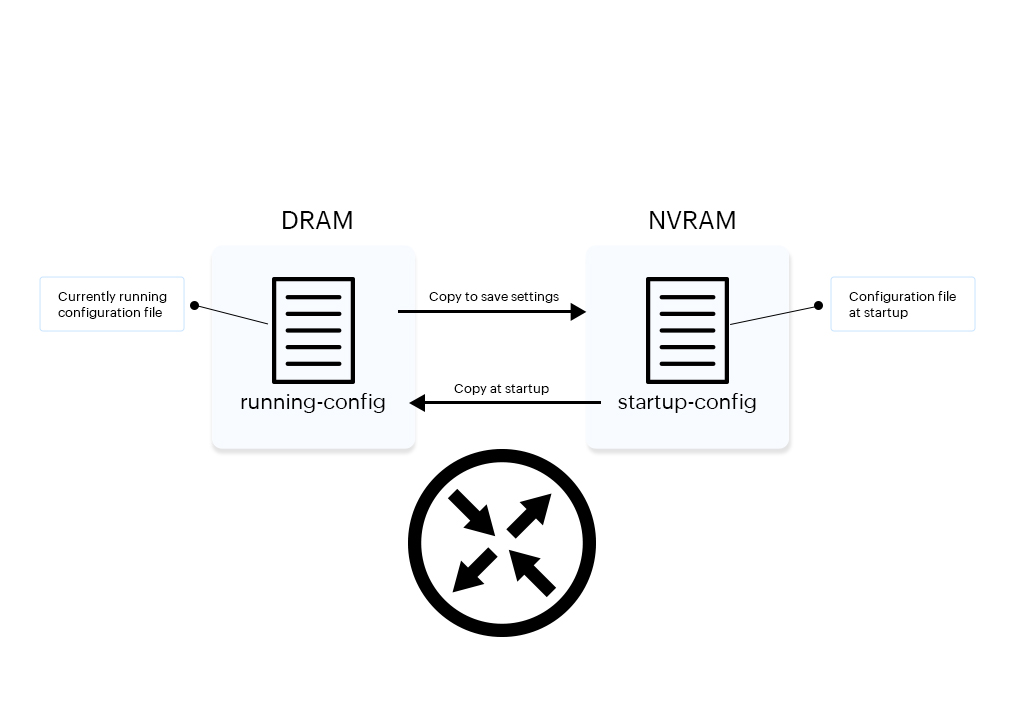Startup vs. running configuration conflict: Its impact, and how to avoid it
In a network environment, configurations are crucial for ensuring seamless operations and optimizing performance. Even minor misconfigurations or unauthorized changes can swiftly disrupt the entire network, underscoring the critical importance of meticulous configuration management. Conversely, well-executed configuration adjustments can significantly enhance network efficiency.
A network configuration comprises two elements:
- Startup configuration
- Running configuration
Startup configuration: This configuration defines the settings applied to a network device upon booting or rebooting. It remains static unless deliberately modified and is typically stored in non-volatile memory.
Running configuration: This dynamic configuration reflects the current operational state of the device, incorporating any runtime modifications. It is stored in volatile memory and can be altered in real time.

Why startup and running needs to be in sync: The impact of conflict
A conflict between startup and running configurations in a network device can have significant repercussions on network stability, security, and performance. Let's look at the core impacts of the startup and running configuration conflict.
- Network disruptions:Inconsistencies between startup and running configurations can disrupt operations and lead to service outages. For instance, changes made solely to the running configuration without syncing with the startup configuration may cause the device to revert to default settings upon reboot, interrupting services.
- Security risks:Conflicting configurations may introduce vulnerabilities, compromising network security. Unauthorized changes not synchronized between the running and startup configurations can expose the network to breaches or unauthorized access.
- Configuration drift: Over time, exclusive modifications to the running configuration without corresponding updates to the startup configuration result in configuration drift. This divergence complicates troubleshooting and maintenance efforts, as configurations vary across devices.
To maintain optimal network efficiency and mitigate these risks, synchronization between startup and running configurations is imperative. This involves ensuring that any configuration changes are consistently applied to both settings.
Now, you might be wondering how to synchronize these configurations efficiently without encountering these consequences. The upcoming section will thoroughly explore the best practices.
Effective strategies for preventing startup and running configuration discrepancies
- Regular audits: Conduct routine audits to compare startup and running configurations, identifying disparities. Automated tools can streamline this process by detecting mismatches and facilitating prompt resolution.
- Comprehensive configuration management: Implement thorough documentation and version control systems to systematically document, review, and apply modifications to both startup and running configurations.
- Rigorous change control: Establish protocols for change control, requiring approvals and validation before implementing configuration updates to maintain consistency and integrity.
- Automated configuration deployment: Leverage automation tools to synchronize configurations across devices efficiently, reducing the risk of errors.
- Testing and validation: Prior to implementation, rigorously test configuration changes in a controlled environment to ensure alignment with organizational objectives.
- Training and awareness: Provide training and awareness programs to educate network administrators on best practices and the importance of synchronization between startup and running configurations.
By implementing these measures and leveraging relevant commands, organizations can minimize conflicts between startup and running configurations, thereby enhancing network stability, security, and efficiency.
Commands related to startup-running configurations
- show startup-config: This command reveals the contents of the startup configuration file.
- show running-config: This command shows the contents of the running configuration file.
- startup-config: This command initiates the router boot process by loading a saved configuration file. It copies the contents of NVRAM into RAM, enabling the router to boot using the startup configuration stored in RAM.
- running-config: This command is employed to either examine or modify the current configuration of the router. The running configuration, which resides in RAM, serves as the active configuration for configuring the router.
- reload: This command reboots the router.
- write memory: This command duplicates the running configuration from RAM to NVRAM.
- copy running-config startup-config: This command transfers the active running configuration from RAM to NVRAM.
Conclusion
In summary, ensuring alignment between startup and running configurations is essential to uphold network stability, security, and performance. By following established protocols and utilizing suitable commands and resources, organizations can minimize the threats posed by configuration discrepancies and adeptly manage configuration complexities. Ultimately, taking a proactive stance towards configuration synchronization establishes a robust and adaptable network infrastructure, poised to address the ever-changing requirements of the digital realm.
